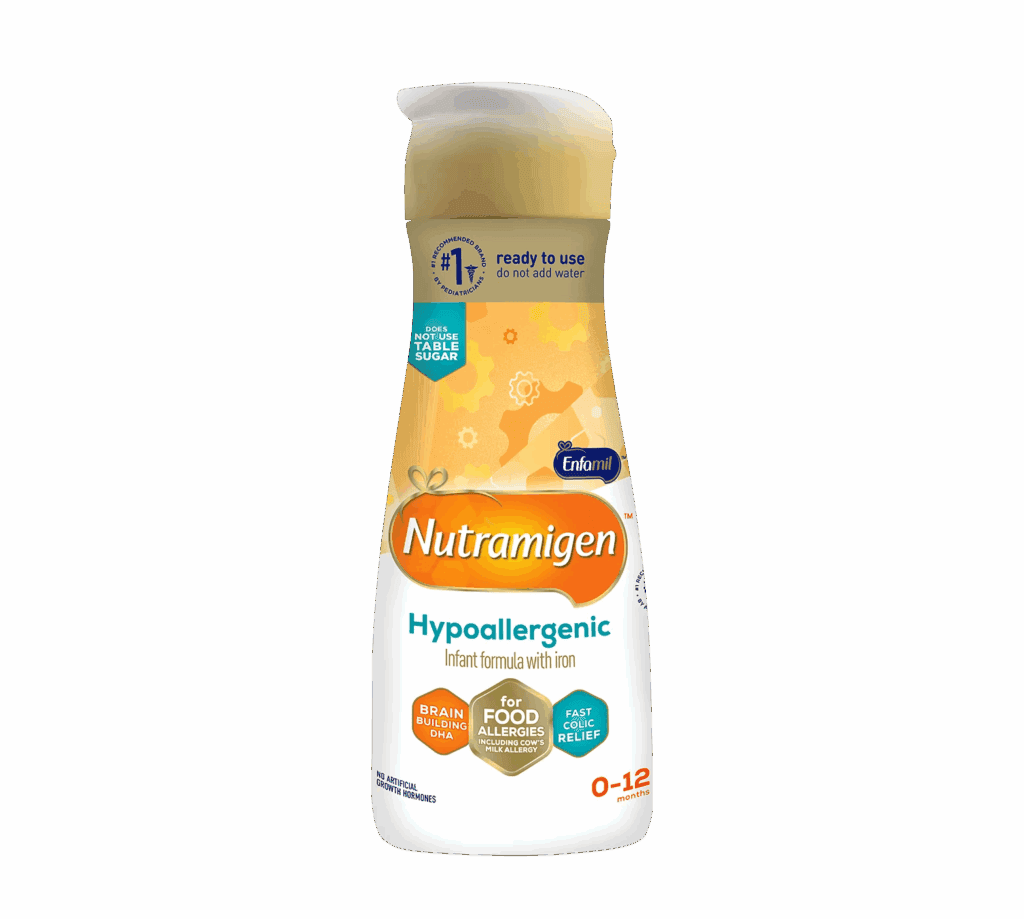Let’s Start With This: You’re Doing What Your Baby Needs
If you’ve landed here, chances are you’re not just choosing formula—you’re searching for relief. Maybe your baby is reacting to dairy. Maybe there’s a diagnosis, or maybe you’re just seeing signs that something isn’t sitting right.
And that can feel heavy. Because when feedings aren’t peaceful, everything else feels harder too.
The good news? There are safe, nourishing, dairy-free formulas that can help—without compromising your baby’s growth or your peace of mind. Each of the options below is thoughtfully designed to support sensitive babies. Whether you’re dealing with a mild intolerance or a complex allergy, there’s a path forward.
Three Thoughtful Options—Choose What Fits Your Baby Best
| When to Consider It | Formula | What Makes It Stand Out | Where to Find It |
|---|---|---|---|
| Your baby has moderate allergy symptoms | Enfamil Nutramigen with Enflora LGG | Extensively hydrolyzed proteins + probiotic to calm the gut and support immunity | Nutramigen – Amazon |
| Your baby reacts to milk and corn | Similac Alimentum Hypoallergenic Formula | Lactose-free, corn-free ready-to-feed version, gentle for multipoint sensitivities | Alimentum – Amazon |
| Nothing else is working / severe allergies | Neocate Infant DHA/ARA | 100% amino acid–based formula for complex allergy profiles | Neocate – Amazon |
Enfamil Nutramigen with Enflora LGG
For babies with colic, eczema, or mild-to-moderate dairy protein reactions
Why families try it:
Nutramigen is often one of the first formulas recommended for cow’s milk protein allergy (CMPA). It’s based on extensively broken-down milk proteins that are much less likely to cause reactions. It also includes LGG, a probiotic shown to help build tolerance over time.
What’s inside:
- Hydrolyzed casein (tiny protein fragments)
- LGG probiotic for gut balance
- DHA and ARA for brain and vision development
What parents notice:
Many report that symptoms—like rash, reflux, gassiness, or frequent night waking—begin to improve in just a few days. Babies tend to settle more easily and gain weight once the digestive system calms.
Why it helps:
Because the milk proteins are already broken down, they’re less likely to trigger the immune system. And the added probiotic? It helps heal the gut lining and may reduce long-term allergy risk.
Similac Alimentum Hypoallergenic Formula
For babies with dairy and corn sensitivities
Why families choose it:
Alimentum is a gentle, hypoallergenic formula that’s also available in a ready-to-feed (RTF) version that’s corn-free—a big deal if your baby reacts to multiple food ingredients. It’s lactose-free formula, easy to digest, and made with proteins that are pre-broken down.
What’s inside:
- Hydrolyzed casein
- DHA, lutein, and vitamin E
- Sucrose and modified starch (in RTF version)
What parents notice:
Parents often notice changes in just 24–48 hours: reduced spit-up, less crying, and more restful sleep. Some also report clearer skin and less mucus in stools.
Why it helps:
Like Nutramigen, the proteins are broken down, but the RTF version avoids corn, which can be a hidden irritant for some babies. It’s a flexible option for complex sensitivities.
Neocate Infant DHA/ARA
For babies who don’t tolerate anything else
Why families rely on it:
When everything else causes discomfort—vomiting, poor weight gain, rashes—this is the formula that often turns things around. Neocate is completely amino acid–based, meaning there are no intact proteins at all. It’s designed for the most sensitive little bodies.
What’s inside:
- 100% free amino acids
- Corn syrup solids and essential fats
- DHA and ARA
What parents notice:
In many cases, it’s described as a turning point. Babies who were in distress begin to eat comfortably. Parents say they finally feel confident feeding again.
Why it helps:
This formula doesn’t just reduce allergens—it eliminates them. It’s often used for babies with FPIES, severe CMPA, or multiple food allergies, and is considered the most hypoallergenic option available.
Final Thoughts: Watch, Listen, and Adjust as Needed
Choosing formula isn’t about following a chart or picking the “best.” It’s about watching your baby. Listening to your instincts. Seeing what helps—and being willing to pivot if something doesn’t feel right.
These formulas are carefully made, deeply researched, and trusted by pediatricians. But they’re still just tools. The real work is what you’re doing: showing up, feeding with love, and trying again when something doesn’t feel quite right.
That’s what your baby needs most. And you’re already doing it.
Citations
- Anafy, A. et al. (2021). The Glycemic Response to Infant Formulas: A Randomized Clinical Trial. Nutrients, 14. https://doi.org/10.3390/nu14051064
- Maryniak, N. et al. (2022). Alternatives to Cow’s Milk-Based Infant Formulas in the Prevention and Management of Cow’s Milk Allergy. Foods, 11. https://doi.org/10.3390/foods11070926
- Verduci, E. et al. (2019). Cow’s Milk Substitutes for Children: Nutritional Aspects of Milk from Different Mammalian Species, Special Formula and Plant-Based Beverages. Nutrients, 11. https://doi.org/10.3390/nu11081739
- Tang, J., Wichers, H., & Hettinga, K. (2024). Evaluation of Plant Proteins as Dairy Substitutes in Infant Formula. Trends in Food Science & Technology. https://doi.org/10.1016/j.tifs.2024.104528
- Urashima, M. et al. (2019). Primary Prevention of Cow’s Milk Sensitization and Food Allergy by Avoiding Supplementation With Cow’s Milk Formula. JAMA Pediatrics. https://doi.org/10.1001/jamapediatrics.2019.3544


